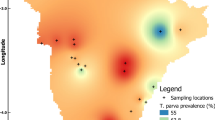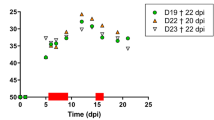Abstract
Ticks can transmit viruses, bacteria, and parasites to humans, livestock, and pet animals causing tick-borne diseases (TBDs) mechanically or biologically in the world. Lumpy skin disease virus, Anaplasma marginale, and Theileria annulata inflict severe infections in cattle, resulting in significant economic losses worldwide. The study investigated the potential transmissions of LSDV, A. marginale, and T. annulata through male Hyalomma anatolicum ticks in cattle calves. Two 6-month-old Holstein crossbred calves designated as A and B were used. On day 1, 15 uninfected female ticks (IIa) and infected batch of 40 male ticks (I) were attached on calf A for 11 days. Filial transmission of the infections was observed in female ticks (IIb) collected from calf A, where 8 female ticks had been co-fed with infected male ticks. The blood sample of calf B was found positive through PCR for the infections. The larvae and egg pools obtained from the infected ticks were also tested positive in PCR. The study confirmed the presence of these mixed pathogens and potential intra-stadial and transovarial transmissions of A. marginale, T. annulata, and LSDV in male and female ticks of H. anatolicum and experimental calves to establish the feasibility of infections through an in vivo approach.





Similar content being viewed by others
Data availability
Data will be made available on resealable request.
References
Alekseev, A.N., and Dubinina, H.V., 1996. Exchange of Borrelia burgdorferi between Ixodes persulcatus (Ixodidae: Acarina) sexual partners, Journal of medical entomology, 33, 351–354
Alekseev, A.N. et al., 1999. Sexual transmission of Borrelia garinii by male Ixodes persulcatus ticks (Acari, Ixodidae), Experimental & applied acarology, 23, 165–169
Ali, Z. et al., 2013. Prevalence of Theileria annulata infected hard ticks of cattle and buffalo in Punjab, Pakistan, DNA, 862, 846
Ali, A. et al., 2019. Seasonal dynamics, record of ticks infesting humans, wild and domestic animals and molecular phylogeny of Rhipicephalus microplus in Khyber Pakhtunkhwa Pakistan, Frontiers in physiology, 10, 793
Ali, S. et al., 2023. Molecular prevalence of Anaplasma marginale in ruminants and Rhipicephalus ticks in northern Pakistan, Tropical Biomedicine, 40, 7–13
Aubry, P., and Geale, D., 2011. A review of bovine anaplasmosis, Transboundary and emerging diseases, 58, 1–30
Battsetseg, B. et al., 2002. Detection of natural infection of Boophilus microplus with Babesia equi and Babesia caballi in Brazilian horses using nested polymerase chain reaction, Veterinary parasitology, 107, 351–357
Bishop, R.P. et al., 2009. Genome mapping and genomics in animal-associated microbes,
Bryson, N. et al., 2002. Ixodid ticks on indigenous goats owned by small-scale farmers in four communal grazing areas in South Africa, Journal of the South African Veterinary Association, 73, 26–30
Carn, V., and Kitching, R., 1995. An investigation of possible routes of transmission of lumpy skin disease virus (Neethling), Epidemiology & Infection, 114, 219–226
Chihota, C. et al., 2001. Mechanical transmission of lumpy skin disease virus by Aedes aegypti (Diptera: Culicidae), Epidemiology & Infection, 126, 317–321
Chunikhin, S. et al., 1983. Sexual transmission of the tick-borne encephalitis virus in ixodid ticks (Ixodidae), Parazitologiia, 17, 214–217
Davies, F.G., 1991. Lumpy skin disease of cattle: a growing problem in Africa and the Near East, World Animal Review, 68, 37–42
De La Fourniere, S. et al., 2023. Transovarial transmission of anaplasma marginale in Rhipicephalus (Boophilus) microplus ticks results in a bottleneck for strain diversity, Pathogens, 12, 1010
El-Nahas, E. et al., 2011. Isolation and identification of lumpy skin disease virus from naturally infected buffaloes at Kaluobia, Egypt, Global Veterinaria, 7, 234–237
Fereig, R.M. et al., 2017. Seroprevalence of Babesia bovis, B. bigemina, Trypanosoma evansi, and Anaplasma marginale antibodies in cattle in southern Egypt, Ticks and tick-borne diseases, 8, 125–131
Gharbi, M., and Darghouth, M.A., 2014. A review of Hyalomma scupense (Acari, Ixodidae) in the Maghreb region: from biology to control, Parasite, 21,
Ghosh, S., and Azhahianambi, P., 2007. Laboratory rearing of Theileria annulata-free Hyalomma anatolicum anatolicum ticks, Experimental and Applied Acarology, 43, 137–146
Ghosh, S. et al., 2007. Status of tick distribution in Bangladesh, India and Pakistan, Parasitology research, 101, 207–216
Hembram, P.K. et al., 2022. Molecular detection of pathogens in the ova and unfed larvae of Rhipicephalus annulatus and Haemaphysalis bispinosa ticks infesting domestic cattle of south India, Acta Tropica, 235, 106656
Hussain, S. et al., 2024. Exploring the Coinfection and Genetic Diversity of Multiple Tick-Borne Pathogens in Livestock Population of Punjab, Pakistan, Transboundary and Emerging Diseases, 2024,
Ikadai, H. et al., 2007. Molecular evidence of Babesia equi transmission in Haemaphysalis longicornis, American Journal of Tropical Medicine and Hygiene, 76, 694–697
Issimov, A. et al., 2020. Mechanical Transmission of Lumpy Skin Disease Virus by Stomoxys spp.(Stomoxys calsitrans, Stomoxys sitiens, Stomoxys indica), Diptera: Muscidae, Animals, 10, 477
Jabbar, A. et al., 2015. Tick-borne diseases of bovines in Pakistan: major scope for future research and improved control, Parasites & vectors, 8, 1–13
Kakati, P. et al., 2015. Emergence of oriental theileriosis in cattle and its transmission through Rhipicephalus (Boophilus) microplus in Assam, India, Veterinary World, 8, 1099
Kocan, K.M. et al., 1992. Persistence of Anaplasma marginale (Rickettsiales: Anaplasmataceae) in male Dermacentor andersoni (Acari: Ixodidae) transferred successively from infected to susceptible calves, Journal of medical entomology, 29, 657–668
Kumar, N. et al., 2019. Molecular Assessment of Anaplasma marginale in Bovine and Rhipicephalus (Boophilus) microplus Tick of Endemic Tribal Belt of Coastal South Gujarat, India, Acta Parasitologica, 64, 700–709
Lubinga, J.C. et al., 2013. Detection of lumpy skin disease virus in saliva of ticks fed on lumpy skin disease virus-infected cattle, Experimental and Applied Acarology, 61, 129–138
Lubinga, J.C. et al., 2014a. Evidence of lumpy skin disease virus over-wintering by transstadial persistence in Amblyomma hebraeum and transovarial persistence in Rhipicephalus decoloratus ticks, Experimental and Applied Acarology, 62, 77–90
Lubinga, J.C. et al., 2014b. Evidence of lumpy skin disease virus over-wintering by transstadial persistence in Amblyomma hebraeum and transovarial persistence in Rhipicephalus decoloratus ticks, Experimental and Applied Acarology, 62, 77–90
Manzoor, S. et al., 2023. Molecular characterization of lumpy skin disease virus from recent outbreaks in Pakistan, Archives of Virology, 168, 297
Mekonnen, S. et al., 2002. Acaricide resistance profiles of single-and multi-host ticks from communal and commercial farming areas in the Eastern Cape and North-West Provinces of South Africa,
Naz, S. et al., 2012. Prevalence of theileriosis in small ruminants in Lahore-Pakistan, Journal of Veterinary and Animal Sciences, 2, 16–20
Orynbayev, M.B. et al., 2021. Lumpy skin disease in Kazakhstan, Tropical animal health and production, 53, 1–7
Perveen, F., 2011. Distribution and identification of ixodid tick species on livestock in northern Pakistan, Journal of Agricultural Science and Technology, 1, 73–81
Potgieter, F., Sutherland, B., and Biggs, H., 1981. Attempts to transmit Anaplasma marginale with Hippobosca rufipes and Stomoxys calcitrans,
Randolph, S., Gern, L., and Nuttall, P., 1996. Co-feeding ticks: epidemiological significance for tick-borne pathogen transmission, Parasitology Today, 12, 472–479
Ravindran, R. et al., 2023. Transovarial transmission of pathogenic protozoa and rickettsial organisms in ticks, Parasitology research, 122, 691–704
Rehman, A. et al., 2019. Epidemiology of tick-borne pathogens in the semi‐arid and the arid agro‐ecological zones of Punjab province, Pakistan, Transboundary and emerging diseases, 66, 526–536
Robinson, P., 1982. Theileriosis annulata and its transmission—a review, Tropical Animal Health and Production, 14, 3–12
Schroder, B., Uys, A., and Reilly, B., 2006. A survey of free-living ixodid ticks on a commercial game farm in the Thabazimbi District, Limpopo Province, South Africa, Journal of the South African Veterinary Association, 77, 141–144
Scoles, G.A., and Ueti, M.W., 2013. Amblyomma cajennense is an intrastadial biological vector of Theileria equi, Parasites & vectors, 6, 1–9
Shimada, M.K. et al., 2004. Detection of Anaplasma marginale DNA in larvae of Boophilus microplus ticks by polymerase chain reaction, Annals of the New York Academy of Sciences, 1026, 95–102
Shweta, K., U, K.A., and Rajat, G., 2014. Outbreak of theileriosis and anaplasmosis in herd of holstein crossbred cows of Dehradun district of Uttranchal, India: A Himalyan region, International Journal of Livestock Production, 5, 6–9
Tageldin, M.H. et al., 2014. Lumpy skin disease of cattle: an emerging problem in the Sultanate of Oman, Tropical animal health and production, 46, 241–246
Tuppurainen, E.S. et al., 2011. A potential role for ixodid (hard) tick vectors in the transmission of lumpy skin disease virus in cattle, Transboundary and emerging diseases, 58, 93–104
Tuppurainen, E. et al., 2013a. Mechanical transmission of lumpy skin disease virus by Rhipicephalus appendiculatus male ticks, Epidemiology & Infection, 141, 425–430
Tuppurainen, E.S. et al., 2013b. Evidence of vertical transmission of lumpy skin disease virus in Rhipicephalus decoloratus ticks, Ticks and Tick-Borne Diseases, 4, 329–333
Ul-Rahman, A. et al., 2022. First emergence of lumpy skin disease in cattle in Pakistan. 2022, (Wiley Online Library,
Walker, A., Matthews, J., and Preston, P., 2005. The development of electronic keys for the identification of ticks, International Journal of Tropical Insect Science, 25, 2–5
Woods, J., 1988. Lumpy skin disease—a review, Tropical animal health and production, 20, 11–17
Zaheer, H. et al., 2020. Expiry of a completely splenectomised calf in post-operative period due to mixed piroplasm infection: A case report, Annals of Parasitology, 66,
Zivkovic, Z. et al., 2007. Experimental transmission of Anaplasma marginale by male Dermacentor reticulatus, BMC veterinary research, 3, 1–6
Acknowledgements
We thank Prof. Dr. Tahir Yaqub from institute of microbiology UVAS Lahore, Pakistan for the provision of control positive of Lumpy skin disease virus. We also thank Mr. Ali Nawaz; student of veterinary medicine of UVAS Lahore, Pakistan for their kind assistance in this study.
Funding
This research was funded by HEC-GCF, grant number 273.
Author information
Authors and Affiliations
Contributions
Conceptualization, M.I.R.; methodology, M.I.R.; software, S.A.; validation, K.A., and J.A.K.; formal analysis, A.S.A.; investigation, S.A.; resources, M.I.R.; data curation, S.A.; writing—original draft preparation, S.A.; writing—review and editing, M.I.R.; visualization, M.I.R. and S.A.; supervision, M.I.R., K.A., A.S.A. and J.A.K.; project administration, M.I.R. and K.A.; funding acquisition, M.I.R. All authors have read and agreed to this version of the manuscript.
Corresponding author
Ethics declarations
Ethical approval
All experimental procedures were performed according to the guidelines approved by the Ethical Review Committee of the University of Veterinary and Animal Sciences (UVAS), Lahore (No. DR/420, Dated: 13-10-21).
Conflict of interest
The authors declare no competing interests.
Additional information
Publisher’s Note
Springer Nature remains neutral with regard to jurisdictional claims in published maps and institutional affiliations.
Rights and permissions
Springer Nature or its licensor (e.g. a society or other partner) holds exclusive rights to this article under a publishing agreement with the author(s) or other rightsholder(s); author self-archiving of the accepted manuscript version of this article is solely governed by the terms of such publishing agreement and applicable law.
About this article
Cite this article
Ali, S., Ahmad, A.S., Ashraf, K. et al. Insights into the involvement of male Hyalomma anatolicum ticks in transmitting Anaplasma marginale, lumpy skin disease virus and Theileria annulata. Trop Anim Health Prod 56, 167 (2024). https://doi.org/10.1007/s11250-024-04022-x
Received:
Accepted:
Published:
DOI: https://doi.org/10.1007/s11250-024-04022-x




